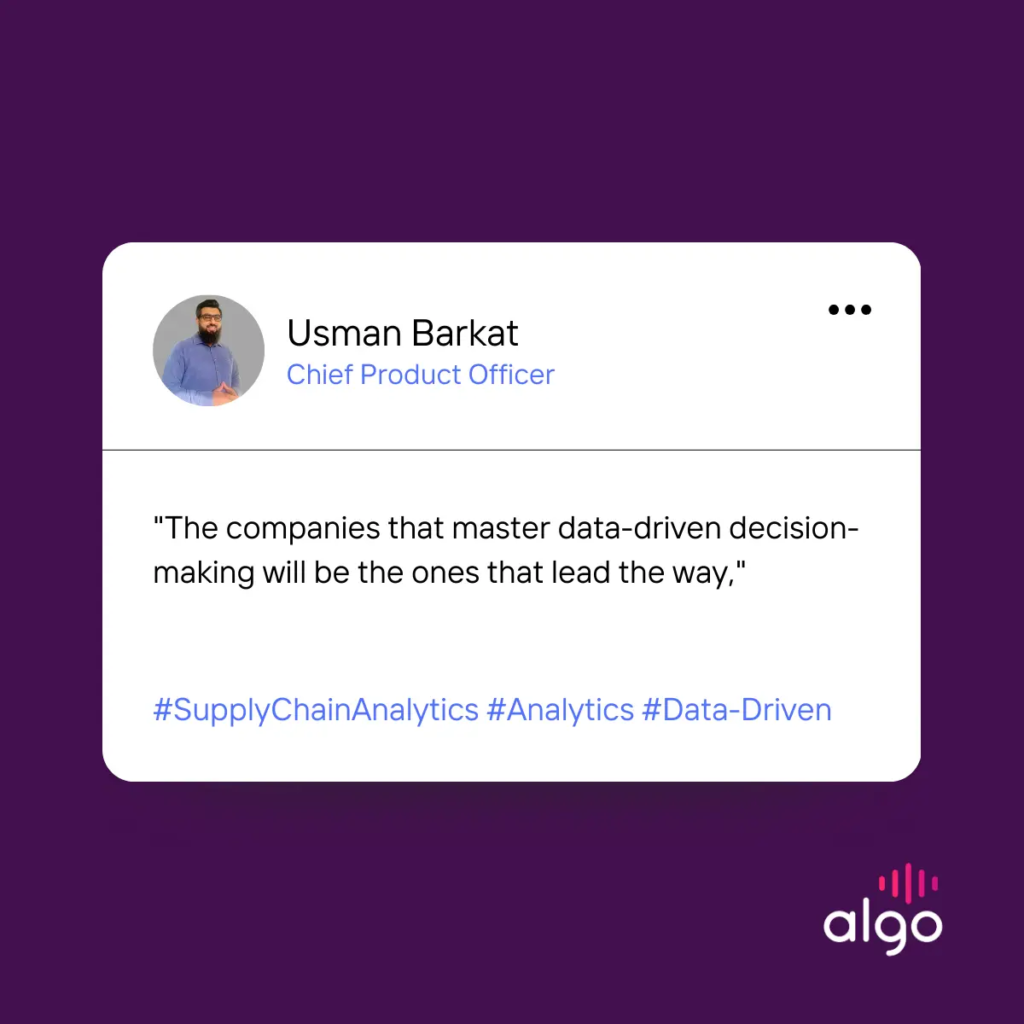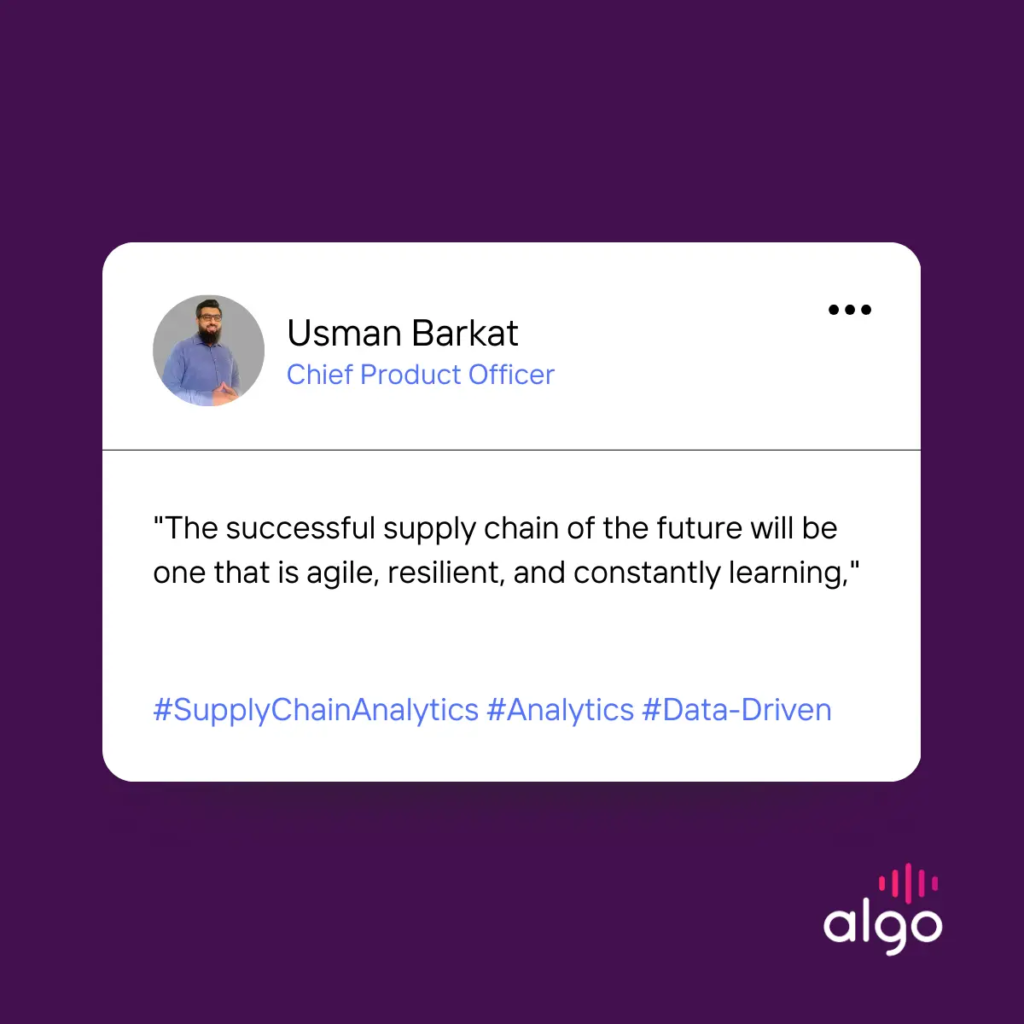Supply chains are the backbone of business, but they’re also complex. Usman Barkat, Chief Product Officer at Algo, says, “Using data the right way is key to staying ahead.” Advanced analytics is that key, transforming how we manage supply chains.
Think of it like this: Analytics is like a toolkit for your supply chain. It can help you:
- See what’s happening now: Like checking your inventory levels or delivery times.
- Predict what’s coming: Like forecasting demand for a product or spotting potential problems.
- Make the best decisions: Like finding the most efficient shipping routes or the optimal price for a product.
Let’s break down these three essential types of analytics: descriptive, predictive, and prescriptive. They’re your roadmap to a smarter, more efficient supply chain.
Three Types of Analytics for Modern Supply Chains
To keep supply chains flowing smoothly and efficiently, you need more than just gut instinct – you need data-driven insights. That’s where advanced analytics comes in, providing the clarity and foresight to navigate the complexities of today’s global supply networks.
But what are the key types of analytics that every supply chain planner needs to know? And how can they transform your operations from reactive to proactive?
“The power of analytics in supply chain lies not just in understanding data, but in translating it into action. Descriptive analytics reveals insights, predictive analytics forecasts outcomes, but prescriptive analytics delivers the actionable recommendations that drive real change and optimization.” Says Usman Barkat, Chief Product Officer at Algo.
Descriptive Analytics: Illuminating the Past
Descriptive analytics involves analyzing historical data to understand what has happened in the supply chain. By examining patterns, trends, and relationships within this data, companies can identify areas for improvement and uncover hidden opportunities. For example, analyzing past sales data can help forecast future demand, enabling companies to optimize inventory levels and avoid stockouts.
Challenges in Supply Chain:
- Data Quality: Inconsistent or incomplete data can lead to inaccurate insights. Ensuring data accuracy and integrity is crucial for reliable descriptive analytics.
- Data Integration: Supply chain data often resides in disparate systems, making it difficult to consolidate and analyze. Effective data integration strategies are essential.
Predictive Analytics: Anticipating the Future
Predictive analytics takes descriptive analytics a step further by using statistical models and machine learning algorithms to forecast future events and trends. By analyzing historical data and identifying patterns, predictive analytics can anticipate potential disruptions, predict customer behavior, and optimize inventory management. This empowers companies to proactively address challenges and make informed decisions.
Challenges in Supply Chain:
- Model Accuracy: Predictive models are only as good as the data they are trained on. Ensuring data relevance and quality is essential for accurate predictions.
- Changing Dynamics: Supply chains are constantly evolving. Models need to be regularly updated and refined to account for new information and changing market conditions.
Prescriptive Analytics: Guiding Decision-Making
Prescriptive analytics builds upon descriptive and predictive analytics by recommending actions to optimize outcomes. It leverages advanced algorithms and optimization techniques to identify the best course of action based on various scenarios and constraints. For instance, prescriptive analytics can suggest optimal inventory levels, transportation routes, and pricing strategies to maximize profitability and customer satisfaction.
Challenges in Supply Chain:
- Complexity: Supply chains are complex systems with numerous interconnected variables. Building accurate prescriptive models requires a deep understanding of these intricacies.
- Implementation: Translating prescriptive insights into actionable recommendations and implementing them effectively can be challenging, requiring collaboration across different departments and stakeholders.
The Future of Supply Chain Analytics
Usman Barkat believes that embracing these three types of analytics is not just a trend, but a necessity for the modern supply chain.
“The sheer volume of data available to supply chain planners is staggering. The challenge now is to transform this data deluge into a strategic asset.” says Usman Barkat.

This is where the future of supply chain analytics lies: not just in crunching numbers, but in harnessing the power of artificial intelligence (AI), machine learning (ML), and real-time data to make smarter, faster, and more informed decisions. “The companies that master data-driven decision-making will be the ones that lead the way,” he says. Usman also envisions a future where supply chains are not just reactive, but proactive and self-optimizing. “Imagine a supply chain that can anticipate disruptions, predict demand fluctuations, and autonomously adjust to minimize risk and maximize efficiency,” he says.
The rise of the Internet of Things (IoT) is playing a crucial role in this evolution, generating a wealth of real-time data from sensors embedded in products, vehicles, and warehouses. This data, when combined with advanced analytics, offers unprecedented visibility into the entire supply chain ecosystem.
Furthermore, the democratization of analytics tools is empowering supply chain planners at all levels to become data-savvy decision-makers. As Barkat points out, “Self-service BI tools are putting the power of analytics directly into the hands of those who need it most, enabling them to ask their own questions and uncover their own insights.”
But the future of supply chain analytics goes beyond just tools and technology. It’s about a fundamental shift in mindset, where data-driven decision-making becomes ingrained in every aspect of supply chain management.

“The successful supply chain of the future will be one that is agile, resilient, and constantly learning,” says Barkat. “And analytics will be the engine that drives this transformation.”
The journey towards this future is already underway, and the companies that embrace this data-driven revolution will be the ones that thrive in the increasingly complex and interconnected world of global supply chains.
About the author
Usman Barkat
Usman Barkat is the Chief Product Officer at Algo, where he spearheads product strategy and innovation in the supply chain sector. With 15+ years of experience in merchandising, planning, and operations, Usman excels in driving efficiency and growth.


